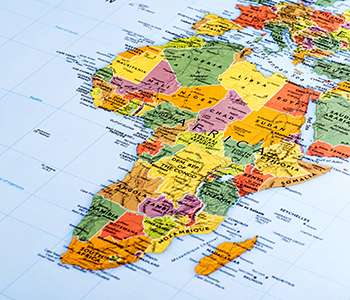
Most of the international students at the UFS come from
the Southern African Development Community (SADC)
and other countries in Africa.
Photo: iStock
“Africa Month provides an opportunity
to every student and staff member to
commemorate African unity and celebrate
our rich cultural heritage, diversity,
energy and social dynamism.”
The University of the Free State (UFS) celebrates Africa Month to commemorate African unity and praise cultural heritage, as well as to take ownership of the future of the continent. According to Prof Heidi Hudson, Director of the Centre for Africa Studies, these are reasons to take part in the festivities.
Formation of Organisation of African Unity
Africa Day is the day on which Africa observes the creation of the Organisation of African Unity (OAU) on 25 May 1963. A total of 32 independent African states attended the formation.
The OAU’s aims were to promote unity and solidarity of the African states and act as a collective voice for the continent, in order to secure Africa’s long-term economic and political future and to rid it of remaining forms of colonialism. The OAU later gave birth to the African Union, which formally replaced the OAU in July 2002.
Prof Hudson says celebrating Africa Month forms part of her centre’s institutional mandate to promote an African focus in research, teaching, as well as public debate.
“Africa Month provides an opportunity to every student and staff member to commemorate African unity and celebrate our rich cultural heritage, diversity, energy and social dynamism. Secondly, by participating we all begin to take ownership of our future on this continent.”
She adds that Africa month provides a platform for reflecting on past experiences and achievements, as well as to critically assess the failures, challenges and the lessons learnt for the sake of a better future for the continent’s people.
Working relations across the continent
The UFS has working relations with universities, embassies and consulates in African countries such as Zimbabwe, Mozambique, Botswana, Zambia, Kenya, Namibia, Nigeria, Ghana, Uganda, and Tunisia.
Five cooperation agreements exist – they are with the Botho University (Botswana), Greater Zimbabwe University, Universidad Eduardo Mondlane (Mozambique), Trinity Theological Seminary Ghana, and Namibia Evangelical Theological Seminary.
According to Kanego Mokgosi, Senior Officer at Internationalisation, there are also working relations between the university and The Council for the Development of Social Science Research in Africa, Swedish International Development Agency and The United Nations Educational, Scientific and Cultural Organization. All of these focus on research development in Africa.
Most of the international students at the UFS come from the Southern African Development Community (SADC) and the continent. It hosts 1393 students from SADC countries.
“The UFS employs SADC protocol guidelines which, among others, enjoin SADC universities to admit at least 5% of their student population from the SADC region,” says Mokgosi.
Memorial Lecture by Dr Zeleza
On 24 May 2017 the Centre for Africa Studies hosted an Africa Day Memorial Lecture by Dr Paul Tiyambe Zeleza, the Vice Chancellor (President) of the United States International University Africa, Nairobi, Kenya.
The UFS library, in collaboration with the Department of English and the Office of International Affairs, also celebrated Africa Day on 25 May 2017. They hosted a conversation on the Land Debate in South Africa, together with the launch of a book titled White Narratives: The depiction of Post-2000 Land Invasions in Zimbabwe by Prof Irikidzayi Manase. He is an Associate Professor in the Department of English.